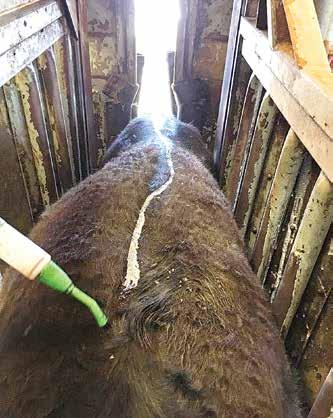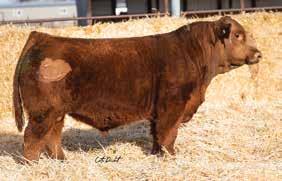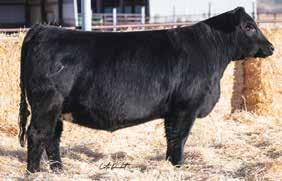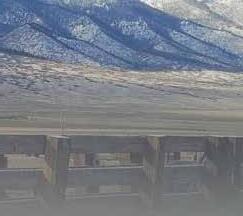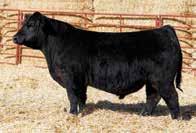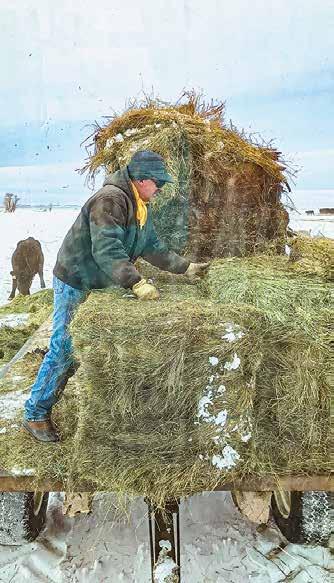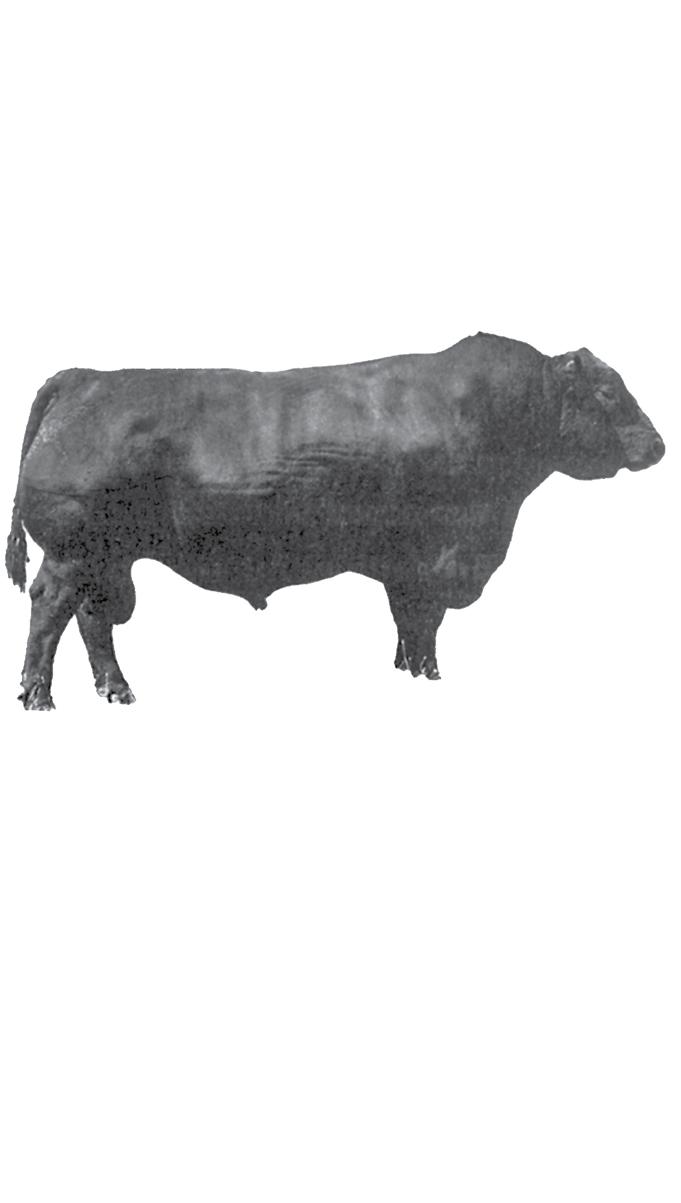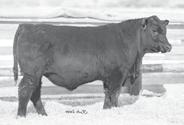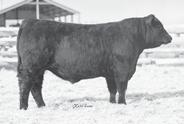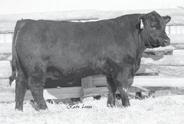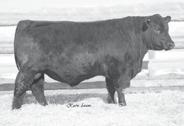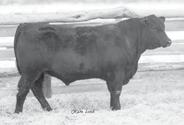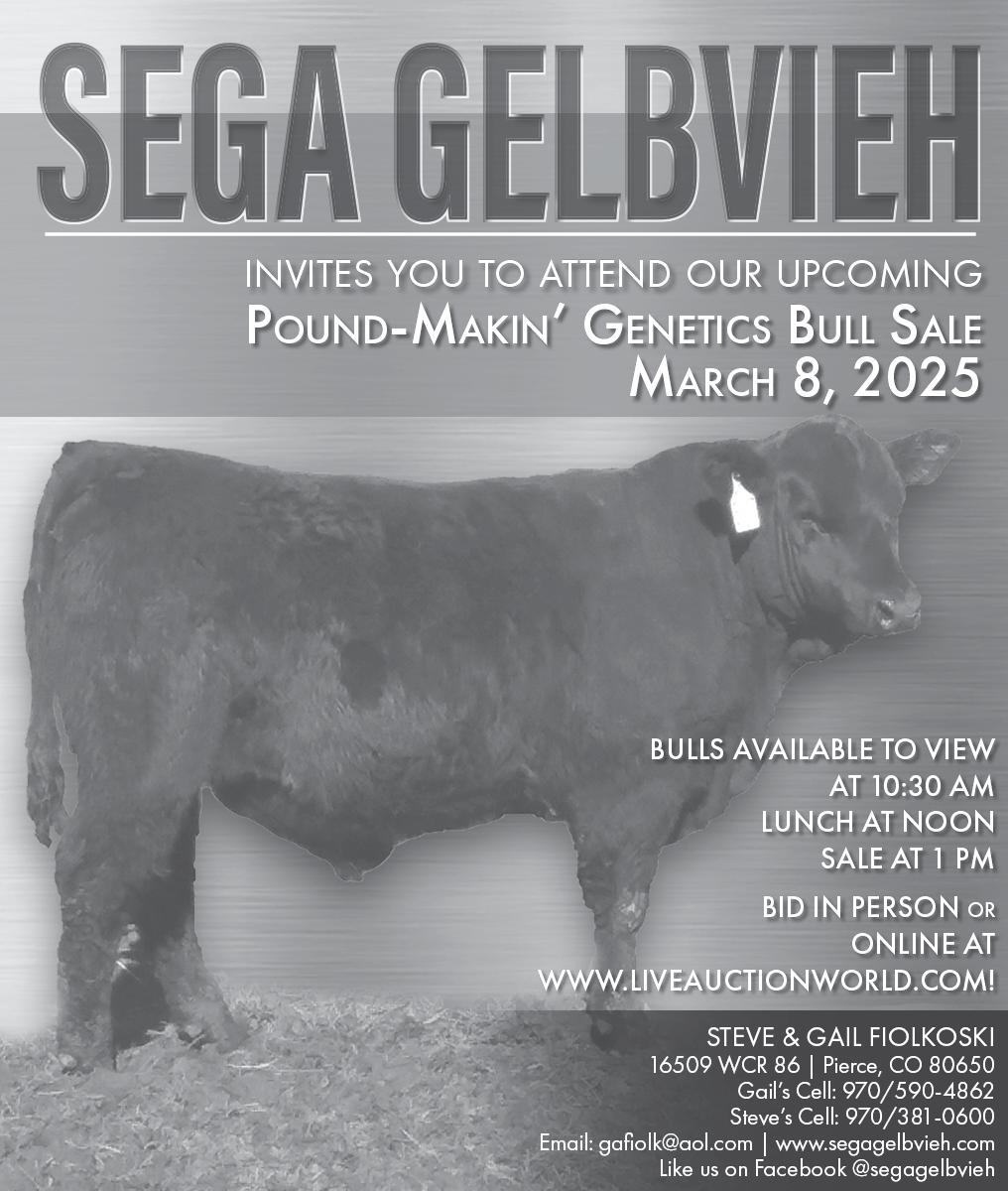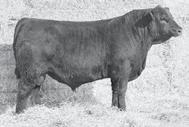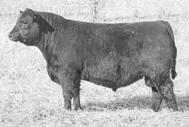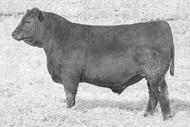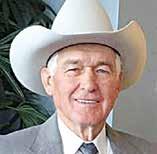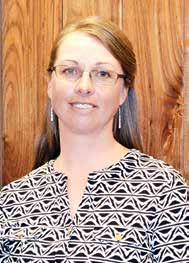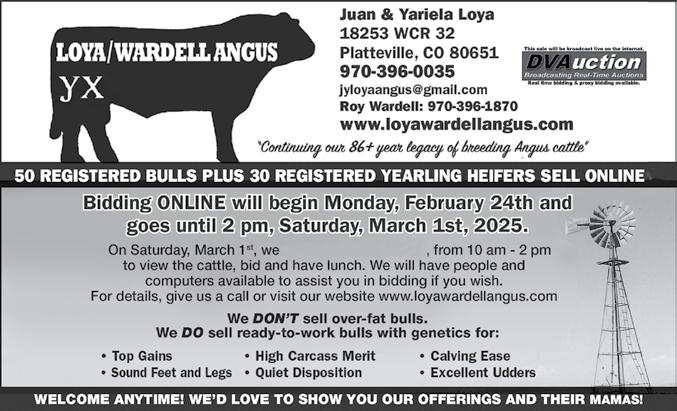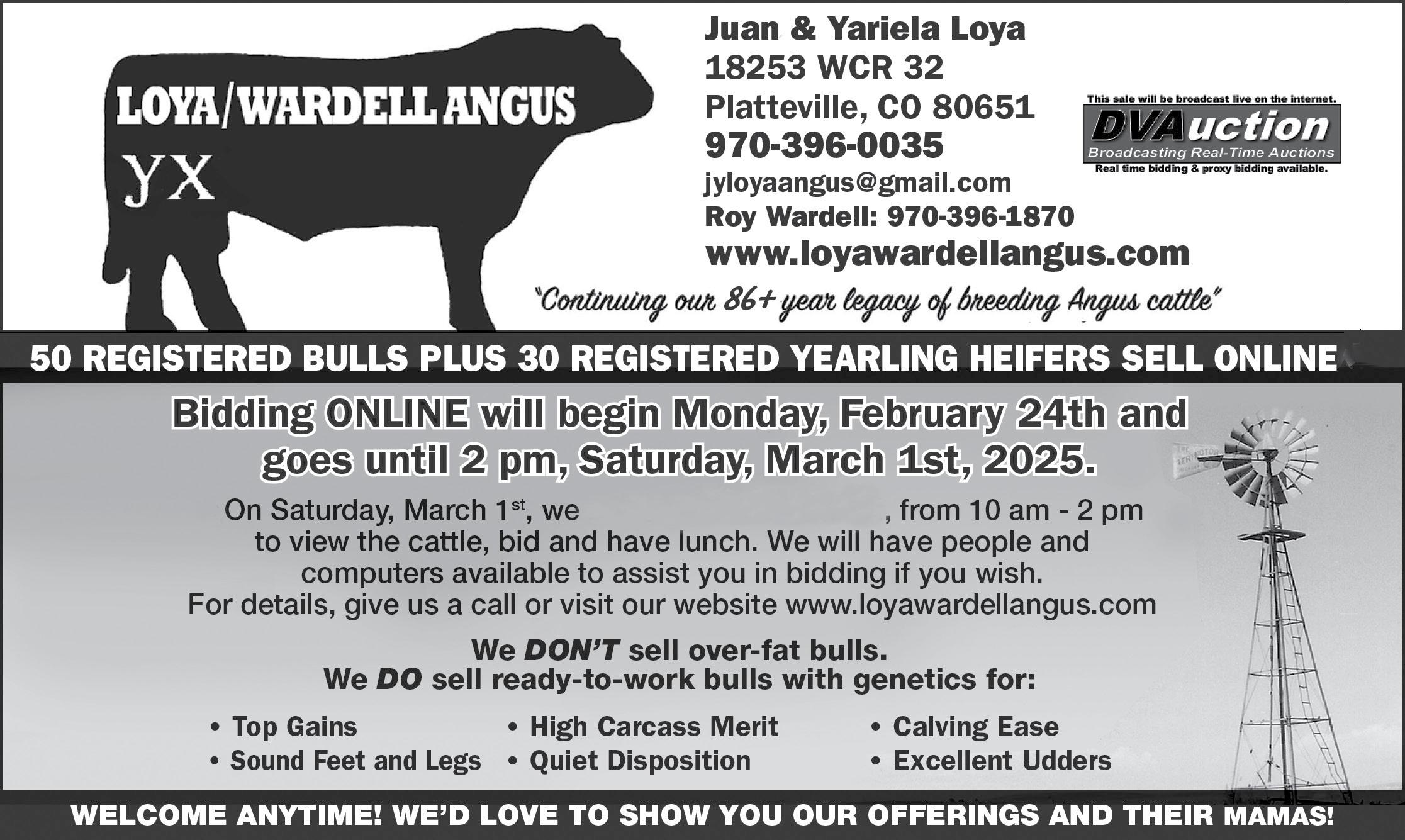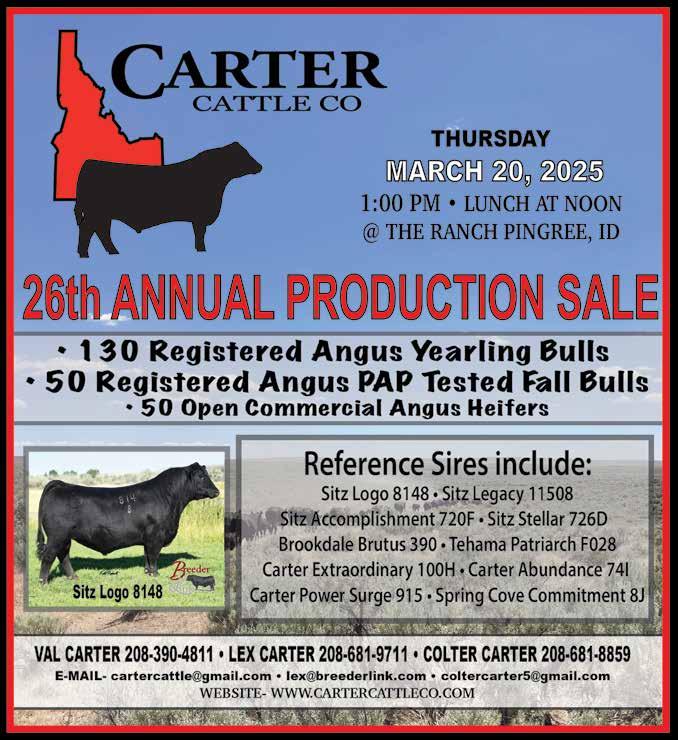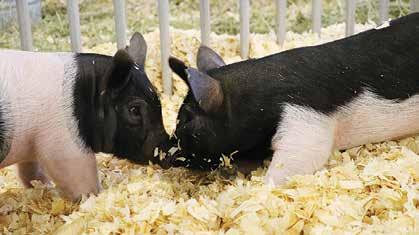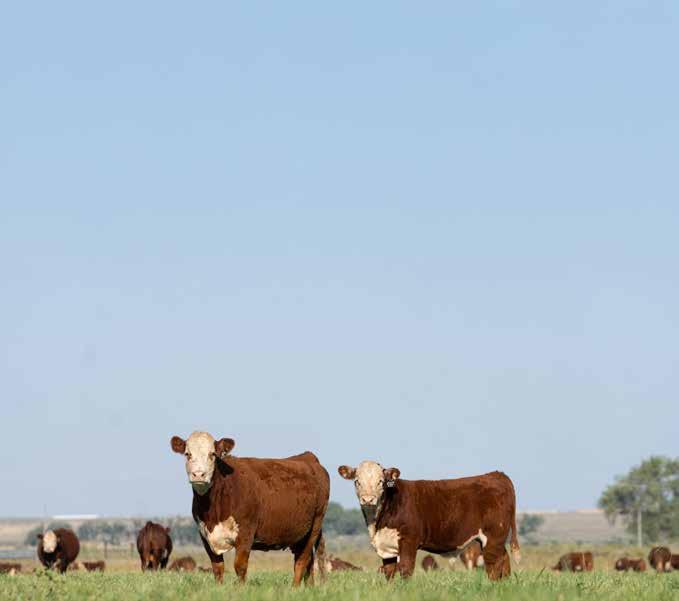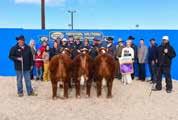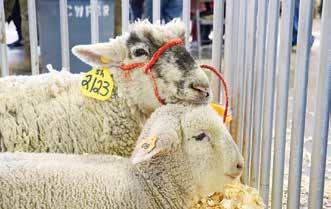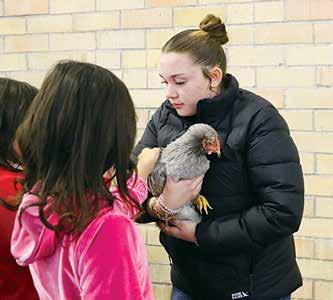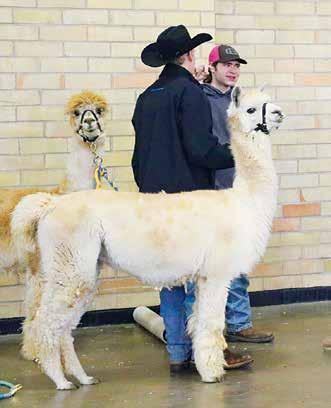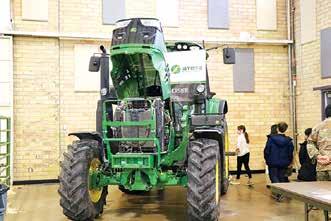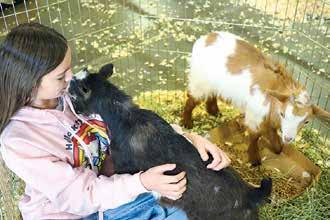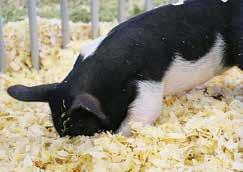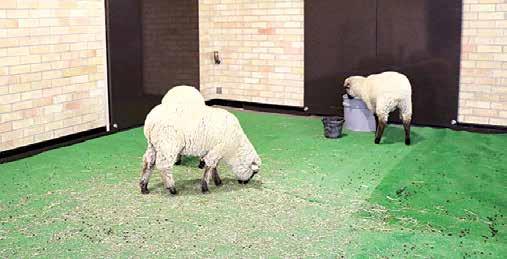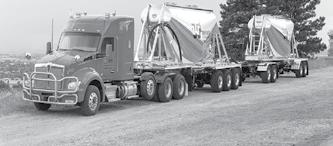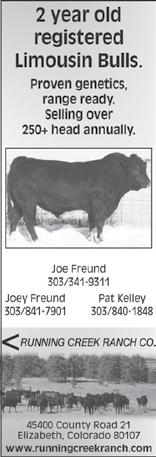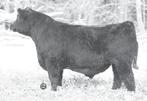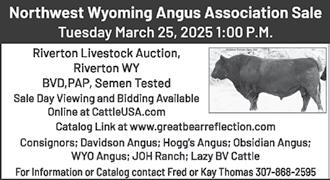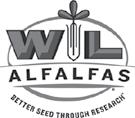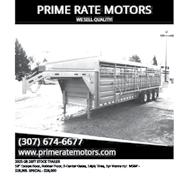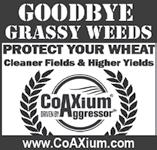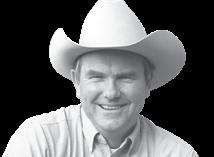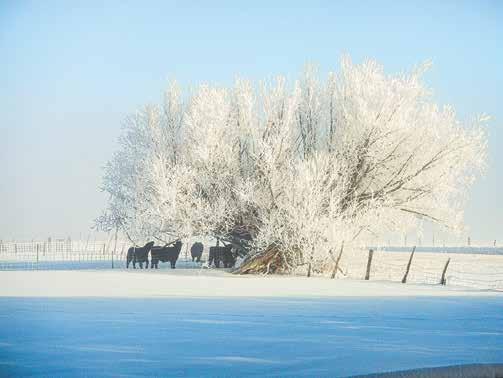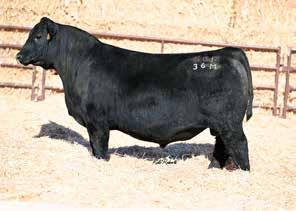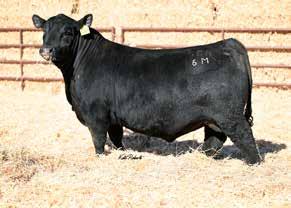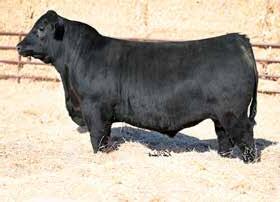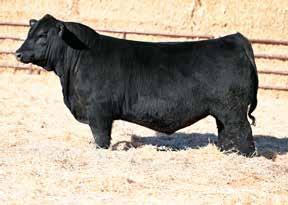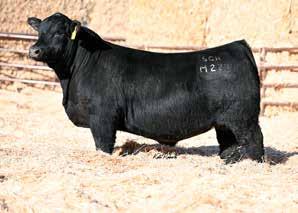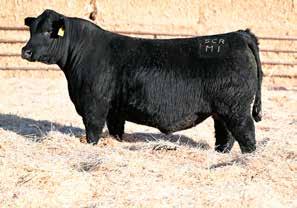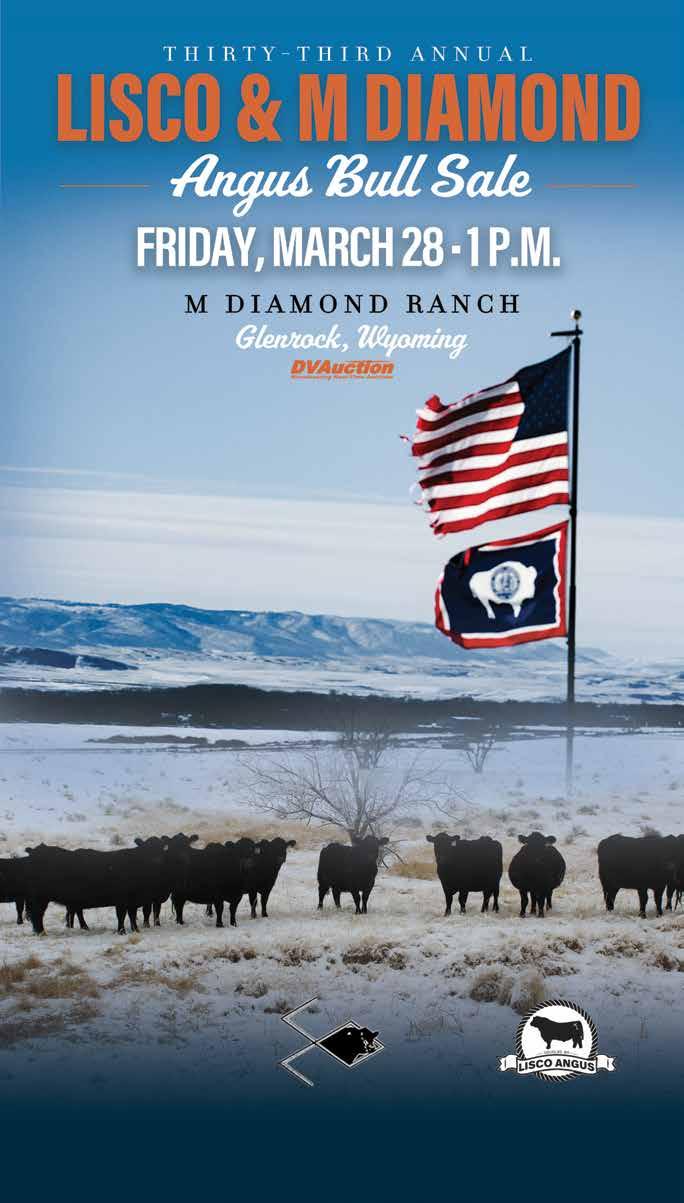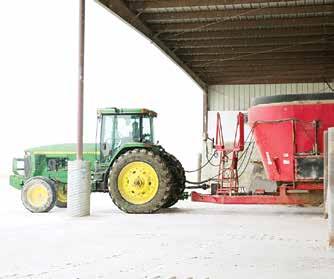Producers urged to plan for lice control this winter
the spring.
Clinical signs of liceinfested cattle generally begin with behavioral changes such as rubbing and scratching within the herd. Fences, posts, water troughs, trees and any other stationary object could be subject to damage from this rubbing. As the infection and irritation continues, large hairless patches will become evident on animals.
Further diagnosing the issue beyond the clinical signs requires seeing the adult lice on the skin. Parting the hair will reveal the lice. They are very small, but can still be seen. They are roughly the size of a grain of sand.
The economic threshold for treatment is roughly 10 lice per square inch.
Treatment protocols
There are several options when it comes to treatment of lice in the cow herd.
One option is the macrocyclic lactone class of endectocides. Examples of products in this class include ivermectin, doramectin, eprinomectin and moxidectin. These products come in pour-on formulations and injectable formulations.
Macrocyclic lactones treat internal intestinal nematodes, but also work on external parasites such as lice. It is important to note the injectable formulations do not work on biting lice since they do not feed on blood.
These products are most often used on a herd basis at the end of summer grazing going into winter. Even with herd treatment in the fall, later-season lice infestations can still occur, since they are not active until later in the winter.
The other option is topical treatments which are non-systemic. These products are typically very effec-
tive against adult lice, but they may not affect the larvae or eggs, depending on formulation. Retreatment is often indicated 14 days after initial treatment.
There are products available labeled as a single treatment. They either use an insect growth regulator which interferes with development from eggs or are formulated to stay active long enough to kill
hatching lice.
Use of these particular products eliminates the need to retreat in 14 days.
Since these topical formulations kill lice by contact, it is extremely important to apply them appropriately to cattle. Most formulations call for the pour-on to be applied with full coverage on the topline of animals, from poll to the tailhead. Poor application of
insecticides can lead to reinfestations and the perception of product failure.
When treating cattle, it is also important to treat the entire group. Missing one animal could serve as the reservoir for reinfesting the entire herd. The same thought should be given to new additions to the herd from an outside source.
Basic biosecurity such as treating and segregating
new additions for 30 days is not only good to reduce risk of lice infestation, but is also a great tool in decreasing introduction of other diseases.
AJ Tarpoff is an associate professor and beef Extension veterinarian for Kansas State University. This article was originally published in the K-State Beef Tips newsletter on Dec. 31, 2024.
After a short hiatus, University of Wyoming (UW) Extension brought back WESTI Ag Days this year with a focus on alfalfa production. The one-day event was held on Feb. 12 at the Washakie Museum and Cultural Center in Worland and was free to the public.
Following a packed schedule of educational programming on everything from alfalfa variety selection and cutting timing to weevil management and blister beetle contamination, UW Department of Agricultural and Applied Economics Senior Research Scientist Brian Lee provided an overview and outlook on Wyoming’s current forage situation.
Weather and drought
To begin, Lee noted it is hard to discuss forage in any capacity without first mentioning weather and drought. He pointed out, although these conditions
•
•
may differ across the state, they tend to affect everyone similarly in regards to hay prices and availability, since hay is a transportable commodity.
“Those who live here in the north-central part of the state are experiencing some different weather and moisture patterns than we are seeing down in southeast Wyoming, where we have had less than four inches of total precipitation since the end of July last year,” Lee mentioned. “It is definitely going to have a huge impact on grass availability.”
However, Lee noted the U.S. Drought Monitor shows a large portion of the state currently affected by drought, which has impacted range conditions, the number of animals producers are keeping and how much forage they need to feed.
“It is less than last year, where 51 percent of the state experienced drought
conditions, compared to 21 percent this year. But, these persistent drought conditions are likely causing range conditions to decrease,” he stated. “And, this is going to have an impact on hay demand.”
Additionally, Lee cited the National Oceanic and Atmospheric Administration’s three-month outlook which shows below average temperatures for most of the state, except for areas in southern Wyoming, which may trend a little warmer than average and is also predicted to receive less precipitation than usual.
Hay stocks
With a milder winter and persistent drought conditions affecting rangelands, pasture and meadows, Lee said the next thing to consider is the state’s hay supply.
“In 2022, we had record low stocks across the nation, which Wyoming was involved,” he
explained. “The year 2023 was actually pretty decent for production and it helped boost our stocks a little bit, but with relatively dry conditions around the state, stocks went down 23 percent in 2024.”
“This matters because storage impacts price,” he added. “It all comes down to supply and demand, in collaboration with range and pasture conditions.”
Price cycle
Additionally, Lee brought up the price cycle, which is currently at its lowest point.
“Right now, we are in somewhat of a stagnant state. There isn’t a lot of hay moving around,” he pointed out. “But, through this cycle, hay prices tend to increase as we move into spring.”
He noted this occurs as producers start purchasing extra hay to get them through to summer, in addition to spring calving, which may require more
hay for pairs and gestating cows.
“Hay prices are going to increase going into summer, as seen in the seasonal index and also because of current range conditions,” explained Lee. “Prices are basically as low as they will go for the year right now, which may be an opportunity for those who need to go out and pick up a little bit extra. Now would be the time.”
Currently, Wyoming hay prices are sitting right on the national average at around $164 to $170 per ton.
Lee noted this number is relatively low compared to recent years due to a combination of higher stocks, rangeland conditions and low demand for hay as a result of the record-
low national herd size, as well as a mild winter which hasn’t required producers to feed as much.
“I don’t think we will see hay prices move around much until the U.S. herd starts to rebuild,” Lee said. “I’ve seen some projections that this probably won’t happen until the end of the year.”
“Another big thing which could impact 202425 supply – and therefore, prices – is if we have an extremely wet first half of the summer which delays haying,” he added. “If first cuttings come off late, it can also have a huge impact on hay prices.”
Hannah Bugas is the managing editor of the Wyoming Livestock Roundup. Send comments on this article to roundup@wylr.net.
Take a drive across South Dakota or any other place in the Great Plains, and one will likely see small ponds dotting the landscape.
These livestock ponds – also known as stock dams, dugouts, farm ponds or reservoirs – have been an essential feature of the region since before the Dust Bowl era. They are primarily human-made and exist in many pastures from Texas to Canada as a way of keeping herds watered.
Cody Knutson, National Drought Mitigation Center (NDMC) planning coordinator, is very familiar with these ponds as a South Dakota native and former ranch kid.
“There’s so many of them built they’re part of our ecosystem and social landscape,” he said. “I learned how to swim in a stock dam, and we had ice skating parties on them in the winter. Many of them had one type of fish, so we’d go from one dam or dugout to another fishing for bass, perch, bluegills, northern pike and bullheads.”
But anecdotal reports of ponds going dry during recent drought – even some which hadn’t been dry before in recent memory – and associated cattle deaths in the Northern Plains prompted new questions about their health and viability.
Why are ponds going dry? How many of them are there? What are ways to help ensure they’re safe to use?
These are just a few of the many questions a new group hosted by the NDMC is trying to address.
A quick stock pond history
Prior to the 1930s, ponds that had been built were often small, shallow and muddy. They were prone to going dry or washing out, which was made abundantly clear during the early days of the Dust Bowl era.
In response, the Soil Conservation Service, predecessor of the Natural Resources Conservation Service (NRCS), started in 1933. It focused on supporting farm practices, such as providing funding for the planning and construction of stock ponds.
On average, these ponds are expected to last 40 to 60 years with a transitional decline in their usefulness over their lifespan, so maintenance and new pond building is a continual task.
The ponds reached peak popularity around the 1970s. Hereafter, the ponds started to be displaced by more cost-effective and reliable wells and pipelines.
During the 20th century, it has been estimated about 2.5 million ponds were built across the country with federal funding alone, maybe eight to nine million including those privately built.
Many of these ponds still exist in various states of condition – used for livestock, irrigation, soil conser-
vation, wildlife, firefighting and recreational purposes.
Growing the group
The NDMC hosts the Great Plains Stock Ponds Working Group in collaboration with the U.S. Department of Agriculture’s (USDA) Northern Plains and Southern Plains Climate Hubs, with support from the USDA Office of the Chief Economist.
The working group is an informal network of agency and university researchers and practitioners interested in livestock pond issues across the Great Plains, including the Canadian prairies region, with a drought emphasis.
Members periodically meet online to share information, discuss research needs and gaps and conduct collaborative activities such as articles and grant proposals.
The idea for the group germinated around 2021, when the USDA Northern Plains Climate Hub was hearing from ranchers about their stock ponds drying up and poor water quality in others, causing cattle illness and death.
Although the area was experiencing a drought, the ponds hadn’t been this affected in previous dry times. What changed?
Knutson and a graduate student did a literature review on stock ponds in the Northern Plains. As part of this project, they also talked with university researchers and state and federal employees working with stock ponds.
“The answer I got from NRCS is cost-share funding for livestock water has largely moved from stock ponds to more cost-effective and reliable wells and pipelines,” he said.
While researchers had expected climate to be a main reason for the ponds’ shifting water quality and quantity – which could be partially to blame – it’s likely a more complicated story also involving policy and government investment.
Knutson stumbled into a Pandora’s box of interconnected questions about the ponds’ existence, their impact on the environment and various groups’ reliance on them throughout the decades. Even now, new questions and angles arise.
“Every time I talk to someone new, they bring up a new topic,” he said.
Several different groups were working with these ponds in different ways. This included individuals, researchers and organizations from North Dakota, South Dakota, Montana and Canada.
Knutson saw an opportunity to bring them together into a shared space.
In 2022, the working group met virtually to learn more about others’ capacity in working with stock ponds. They started discussing projects related to monitoring and water quality.
The group’s network
started snowballing from there, including connecting with others in the Central and Southern Plains in 2023.
Producers in these regions have similar water quality issues with their stock ponds, with more concerns about algae blooms, due in part to nutrient pollution and warmer temperatures.
The NDMC hosted a virtual symposium in September 2024 to discuss various issues related to this topic and potential collaborative activities among group
members. The group plans to meet quarterly to stay connected on research and projects.
Looking ahead
Now, over 20 groups across the Great Plains are working together to share information about stock ponds.
The working group is making progress on two publications about the research issues related to stock ponds in the Central and Southern Plains, as well as the Northern Plains.
Some of the priority research themes are bet-
To learn more about the
or to
contact Cody Knutson at cknutson1@ unl.edu.
ter mapping and monitoring stock ponds. This information would be vital to set baseline water quality monitoring and water supply tracking applications.
In many ways, the group’s work circumscribing the extent of the ponds’ existence and impacts has just begun. New questions and perspectives about stock
ponds continue to emerge, such as ecological issues.
“There’s such a wide variety of related topics,” Knutson said. “And this list continues to grow every time we talk to someone else.”
Emily Case-Buskirk is a communications specialist for NDMC. This article was originally published by NDMC on Jan. 31.
The beginning of the new year is a time of anticipation and what better to look forward to than cooking with beef and trying new culinary trends?
With so many trends forecast this time of year, it can be hard to keep up, so the “Beef. It’s What’s For Dinner.” brand, funded by the Beef Checkoff, has gathered some of the most popular food trends for 2025.
As the new year kicks off, it’s no surprise many of the trends focus on fueling up for busy schedules.
High-protein foods
According to recent surveys, more people are looking to incorporate high-protein foods into their diets this year – going beyond protein powders and bars and prioritizing whole foods such as beef.
Along with beef’s great taste, it’s a protein powerhouse and provides a variety of essential nutrients which
support overall health.
For example, a threeounce serving of lean beef provides 10 essential nutrients in about 170 calories, including high-quality protein, zinc, iron and B vitamins.
Dumplings
Dough pockets filled with everyone’s favorite flavors – dumplings – are predicted to be a hit across the globe.
This delicious and convenient class of dishes is not only perfect for food on the go, it also touches on another trend of 2025 where consumers are looking to use more global flavors and spices.
Beef and shiitake dumplings with orange ponzu dipping sauce is a perfect idea for anyone wanting to try out this trend in the coming year.
Breakfast foods
It’s predicted breakfast will be big in the new year, specifically savory
breakfast dishes which are expected to take center stage over sweeter options like pancakes and pastries.
A beef and spinach
CLASSIFIEDS
guarantee the legitimacy of any offer or solicitation. Take reasonable steps to evaluate an offer before you send money or provide personal/financial information to an advertiser. If you have questions or believe you have been the victim of fraud, contact the Wyoming Attorney General’s Office, Consumer Protection Unit, 109 Capitol Building, Cheyenne, WY 82002, 307-7776397 TFN
BLACK HILLS GUN SHOW
MARCH 7-9: The Lodge at Deadwood, in Deadwood, S.D. Call 605-641-0870 or 307-751-1877. Visit us on Facebook 3/1
GUN SHOW MARCH 15-16: Weston County Senior Citizens Center, Newcastle, WY, Sat., March 15, 9 a.m.-5 p.m.; Sun., March 16, 9 a.m.-3 p.m. Admission $5, kids 12 and under free when accompanied by a parent or guardian. Vendor setup Fri., March 14, 3-8 p.m. For more information, call Mike Novotny, 253-678-4825 3/8
2025 CACHE VALLEY COW-
BOY RENDEZVOUS, MARCH 6-9: Welcomes in concert Suzy Bogguss, Paul Overstreet and Bar D Wranglers. Free admission to Cowboy Poetry, Western Music, Vendors and Poetry Contests, etc. Fri. 3-10 p.m. and Sat. 10 a.m.-8 p.m. Cache County Event Center, Logan, UT. Go to www.cvcowboy.org or text/leave message at 435760-0160 2/22
or 402-746-2222 for more information.
DAIRY CALF RANCH MANAGER WANTED: Looking for a good, dependable dairy heifer calf ranch manager. We have between 1,000 and 1,300 calves ranging from 1-day-old to 4 months old at any giving time to be cared for and processed. Knowledge of calf husbandry is a plus. Bilingual is necessary. Time and employee management is a must. Please contact Jeremiah Lungwitz at 970-848-2842, email jlungwitz@hotmail.com or apply in person at Yuma County Dairy, 8798 Co. Rd. 39, Yuma, CO 80759 3/1
Help Wanted
DEVILS TOWER FOREST PRODUCTS INC., A LUMBER MANUFACTURER IN HULETT, WY, IS ACCEPTING APPLICATIONS FOR FULLTIME BOILER/KILN OPERATOR, MILLWRIGHT, PLANER PRODUCTION OPERATORS and BAGGER POSITIONS: Benefit package includes company paid medical and dental insurance (including dependents), life insurance, company-matching 401(k), safety incentives, holiday pay, paid vacation and sign-on bonus. Mandatory employment and random drug testing is conducted. EOE. Starting wage D.O.E. Online applications are available at wwww.neimanenterprises.com. E-mail applications to joe.ortner@ devilstowerfp.com or fax to 307-467-5418, contact Joe Ortner at 307-467-5252 with additional questions 2/22
PEEGEE RANCH NEAR ARVADA, WY IS LOOKING FOR A FULL-TIME FARM/RANCH EMPLOYEE: This position is open immediately. Applicant must be self-motivated, reliable and responsible with knowledge of haying and farming. Mechanical skills are a must. Farming duties include swathing, baling and raking hay, etc. This is not a cowboy position, but applicant will need to assist in all aspects of cattle work as well. Those duties include calving heifers, feeding hay, branding and gathering, etc. Nearest big town is 60+ miles and nearest K-12 school is 30+ miles away (location of the ranch is remote). Housing is provided and on a school bus route. Please send resume with references by mail or e-mail to: PeeGee Ranch, 1251 Lower Powder River Road, Arvada, WY 82831, pgranch@rangeweb.net. Call 307-736-2461 2/22
REGISTERED WYOMING BRAND FOR SALE: LRC, LSS, LSH. Current thru March 2029. Three electric irons, 2 fire irons. $4,000 OBO. Call or text 307-575-7065 3/15
Brands Services
AGRI-ONE FINANCIAL: Farm/ ranch and all commercial loans. RATES AS LOW AS 5%. We have been helping with all aspects of agricultural, commercial financing and management for years. LET US HELP YOU on a consulting level with management to increase profitability, deal with and fix credit problems and for all your financing needs. WE CARE AND HAVE WORKING PROGRAMS designed for the farmer/rancher and not the banker. Please call Steve, 303-773-3545 or check out our website, www.agrionefinancial.com. I will come to you and get the job done!! 2/22
Brands
HISTORIC REGISTERED
WYOMING BRAND FOR SALE: RSC, RSS, RSH, renewed to Jan. 1, 2035, good locations, comes with 1 hot iron and 1 paint brand for sheep. Asking $4,000. Call 307-7142484 2/22
REGISTERED WYOMING BRAND FOR SALE: RRC, RSS, RHH. Renewed to Jan. 1, 2035. $2,500 OBO. Call 403-894-4411 3/15
REGISTRED WYOMING BRAND FOR SALE: LSC, RHS, LBH. Registered to 2029, $4,000. Call 307202-0644 3/1
FOR SALE: Wyoming registered 1 iron (2) letter brand registered on all 3 species and in good locations, RRC, RSS, RSH. One hot iron available. Asking $4,995 for this easy to read brand, registered until 2031. Call or text 307-254-2790 if interested 3/1
AKC LAB PUPPIES: All colors available, whites, blacks, yellows, dark chocolates and dark reds. Excellent hunters, family companions. Full AKC registration. Shots, wormed, dewclaws removed. All puppies are cute, but it’s what they grow into that counts. Not all Labs are the same. Proud to own!! Been raising quality AKC Labradors for 30-plus years. Look at the rest but buy the best. Both parents on site for viewing. Will sell quickly!! $200 deposit, picking order is when the deposit is received. Doug Altman, Mitchell, S.D. Call/text 605999-7149, click the “Our Labs” tab on the website for pictures, www.southdakotayellowlabs. com 3/1
REGISTERED STANDARD AUSSIE PUPPIES: Tails docked, back dewclaws removed, have first and second shots. Working dogs, parents onsite. Two tri females. Ready now, $300. Call 406-281-0712 for info and pictures 3/1
REGISTERED WYOMING BRAND: RRC. Current through Jan. 1, 2031. $3,500 OBO. Contact Gene at 307-331-1049 2/22
REGISTERED WYOMING BRAND: LRC, LSH. Current through Jan. 1, 2031. $3,500 OBO. Contact Gene at 307-331-1049 2/22
WYOMING BRAND FOR SALE: RRC, RBH&M. Renewed to January 2033. After my husband passed, I sold our ranch. We have a huge sign with the brand on it, a full set of dishes, an electric iron and a standard iron. Also, included with the sale is a mini brand for wooden projects. $1,500 OBO. Currently in Mitchell, NE but willing to meet in Wyoming. Call
2/22
HISTORIC WYOMING BRAND, ORIGINALLY REGISTERED IN 1941:
It has been in the same family for over 80 years and hasn’t been used on livestock for over 40 years. HK bar cattle and horse. LRC, LTH. Double irons. Registered through March 2025. $5,000 OBO if purchased by Feb. 28. $5,500 OBO if purchased after March 1, as it will have been renewed for 10 years on that date. Seller will pay for transfer fee of $137.50 for full purchase price, otherwise will negotiate this fee. Call/text 307-6315659, for more information or to discuss an offer 3/8
REGISTERED WYOMING BRAND: LRC, LHS, LSH, $2,500 or best offer. Call 307-359-0555 3/1
OLD WYOMING ONE IRON, LEFT RIB BRAND FOR SALE: LRC, LHH, 10 year fee paid to March 2035, $12,775. Call 307-334-2760 2/22
WYOMING BRAND FOR SALE: RHC, BS. Irons included. Registered through March 2031, $2,000 OBO. Call Mike at 307202-0494 2/22
TW ANGUS 4TH ANNUAL PRODUCTION SALE
March 1-2, 2025 on DV Auction
Bids Open Saturday, March 1 at 2 p.m.
Bids Close Sunday, March 2 at 7 p.m. CST
Videos and catalogs can be found online at www.dvauction.com
TW ANGUS Mitchell, South Dakota Tate Williams: (605) 999-0018 Calli Williams: (605) 695-1990
RegisteRed Angus Bulls Opening dAy sAle
Sires Include: Regiment • Republic • Brigade Saluda • Armstrong • Statesman Many suitable for heifers. Saturday March 15, 2025 Also see our pen of 6 bulls at Midland Bull Test. B ridger , MT
Kathy Dubs & Family • Billings, MT 406-652-7515 • 406-208-8643 windingriverangus@gmail.com
Northwest WY Angus Association 47th Annual Sale Tuesday, March 25, 2025 1:00 PM Riverton Livestock Auction, Riverton, WY
YEARLING ANGUS BULLS: These bulls are grown, not fattened, will get out and cover cows. Many will work on heifers. We will deliver. Call Joe Buseman, 605-351-1535 3/8
120 BLACK ANGUS REPLACEMENT HEIFERS: Uniform group created from our closed herd of females. Will make excellent mothers. Registration papers available. Private treaty sales for nearly 50 years. Let our selective breeding program go to work for you!! Clay Creek Angus, 3334 Rd. 14, Greybull, WY 82426. Call 307762-3541 TFN
Red Angus
RED ANGUS COWS AND HEIFERS FOR SALE: Twentyfive red cows, second and third calvers. ALSO, 6 red heifers. All bred to Leachman and Beckton Red Angus bulls April 15 for 60 days. Located in Torrington, WY. Call 307-231-2883 3/15
RED ANGUS HIGH-ELEVATION
YEARLING BULLS FOR SALE IN NORTHEASTERN UTAH: Out of AI and bull-bred sires. Will be trich, semen tested and fed for free until May 1. $2,700/head. Bar Lazy TL Ranch, David, 435-828-1320, barlazytlranch@ gmail.com 6/14
REGISTERED YEARLING SIMMENTAL AND SIMANGUS
PRIVATE TREATY BULLS FOR SALE: Proven genetics , most are AI sired, calm dispositions, calving ease and growth bulls, black or red available. Will be semen tested and fed until May 1. For more information call, Trenton Adams, 307-751-1515, Warren Adams, 307-737-2429 or 307751-1434, if no answer, leave a message 3/15
Custom Feeding
FAITHFUL FEEDERS: Heifer development, backgrounding, and grass calf prep. Billings, MT. Call Ryan, 406-696-0104 4/12
2024 PALOMINO YEARLING STUD COLT WITH WHITE STOCKINGS: An eye catcher and ready to show. Bet Hesa Cat NRCHA $2 million. Night Time Playmate superior cow horse lifetime earnings $23,000 plus, eligible for SDRCHA stallion stakes. Call 307-532-6200, for more information 3/1
NEW YEAR, NEW BUILD! Call us at 785-734-2663. Our camps are handcrafted with hand-forged iron work. We also offer wooden wagon wheel restoration, wheelwright services. McGilvray Farms
MOFFAT COUNTY SHEEP SHEARING SCHOOL, CRAIG, CO APRIL 4-6: This 3-day shearing school provides handson, instructed experience in shearing sheep and an introduction to equipment maintenance. No previous experience needed. E-mail megan.stetson@colostate.edu or call 970-826-3402 for registration information and questions 3/22
WEANER PIGS FOR SALE, located in Powell, WY. For more information, call 307271-1014 1/17
ALFALFA HAY FOR SALE
1st, 2nd and 3rd Cuttings Core samples tested for protein, TDN Located 20 miles east of Kaycee, WY at Sussex $175/ton Call Lynn Cowden 806-663-6320
CERTIFIED BARLEY STRAW FOR SALE, 3x4 bales. Cody, WY. Call 307-899-1952 TFN
HAY FOR SALE: 3x3 and round bales of grass or alfalfa/grass mix. Prices starting at $70/ton. FOB. Delivered only. Call 605840-0015 2/22
CLEAN ALFALFA AND SOME BARLEY HAY FOR SALE in Riverton, WY area with some trucking available. Call 307-8514532 3/15
STRAW FOR SALE: 200 TONS OF BARLEY STRAW, 4x4 squares, $40/ton. Located west of Powell, WY. Call or text 307-2020532 for more information 3/8
GRASS HAY FOR SALE, 1,400 lb. net-wrapped round bales, $140/bale. Near Laramie, WY. Call 307-760-8429 3/8
MIXED QUALITY OF HAY FOR SALE: Prices range from $60135 per ton. 1,200 lbs., 3x4x8 bales. 2023 or 2024 hay. Delivery available for a fee. Call Kelly Foianini, 307-780-7027 or Bronson Foianini, 307-7602263 3/8
2024 HAY FOR SALE: First, second and third cutting alfalfa/orchardgrass mix, roughly 50/50, round bales. If tests wanted, they can be obtained. Thirty miles east of Valentine, NE, trucking available needed. Call or text for more information, 402-759-2033 3/1
Ranch
Seed
Serving Fremont County, Wyoming and the surrounding areas.
HarvXtra® alfalfa with Roundup Ready® technology, Roundup Ready® alfalfa and conventional varieties available! Plant the best!
VALLEY VIDEO HAY MARKETS, LLC: Hay available. Go to www.valleyvideohay. com or call Barry McRea, 308-235-5386 3/1
2,000 TONS OF HAY FOR SALE: First, second and third cutting alfalfa. All bales are 4x4x8 in size. Location between Lovell and Powell, WY. Contact Crosby Farms, 307-272-3712 3/1
HAY FOR SALE: 2023 milo and grass/alfalfa. 2024 first cutting 90% alfalfa/10% grass mix, grass mix, grass/alfalfa, millet cut early and green, milo cut late in the season. ALSO, 2024 haybet barley, nitrates low, protein high. All in netwrapped round bales. Semi load delivery available. Call for pricing, ask for Klint, 701-290-4418, send a text if no answer or keep trying 3/1
NORTHWEST WYOMING
CERTIFIED GRASS SEED GROWER HAS CERTIFIED GRASS HAY FOR SALE: 3x4x8 bales. 2023 crop approxi mately 1,200 lbs. 2024 crop ap proximately 900+ lbs. $25/bale. Powell, WY area. Call Mike at 307-202-0494 3/22
HORSE QUALITY GRASS HAY, third cutting, barn stored, 3x4 square bales, $200/ton. Lusk, WY. Call Paul Hicks, 970-203-5019 2/22
ROUND-BALED GRASS: 2024 crop $50/bale. 1,000 lb. netwrapped bales. Cody, WY area. Call, don’t text, Anthony at 307-254-2645 3/1
CERTIFIED WEED-FREE PURE ALFALFA HAY: Small squares, covered. 2023 first cutting available for a reduced price. 2024 first, second and third cutting available. Will load trucks and any open trailer. MONIDA OATS, $16/cwt. Combine run. Will auger into truck, trailer or large totes/ag bags. Located between Powell and Cody, WY. Call or text Knopp Farms for details, 307-2540554 3/1
ALFALFA HAY FOR SALE: 3x3 bales shedded. Priced depending on quality and quantity needed. Farson, WY, trucking available. Call 307350-0350 2/22
GRASS AND ALFALFA HAY FOR SALE: Cow and horse quality. Round bales, 3x3 square bales and 3x4 square bales. Delivery available!! Call 307-630-3046 2/22
SHORTHORN BULLS FOR
SALE PRIVATE TREATY: Yearlings up to mature bulls available. Developed conservatively so they hold up. Remember a red Shorthorn bull on your homozygous black cows will give you black calves. Shorthorns are excellent maternal cattle that produce quality beef. Francis-Millvale Shorthorns, Gene and Roberta Francis Family, 701-331-2403, e-mail francis. millvale@gmail.com. To view photos, go to www.wylr.net in the classifieds 3/1
LOOKING TO RENT OR LEASE PASTURE FOR 50-150 cow/calf pairs for 2025, longer or yearly lease if possible. Preferably northeastern Wyoming. Call 307-660-0294 and leave a message if no answer.
PASTURE WANTED AND/OR RANCH OR FARM LEASE, northwest Wyoming or south-central Montana. References available. Call 307-851-2426 2/22
WANTED GRASS FOR YEARLINGS SUMMER OF 2025, references available. Maddux Cattle Company, 308-350-1133 3/1
Ranch for Lease
Wanted PARK COUNTY, WYOMING RANCH NEAR CODY, WY IS AVAILABLE FOR A LONGTERM LEASE: The ranch has over 50,000 acres and supports an irrigated hay base with BOR water rights. Carrying capacity is 700 animal units year-round with hay production. Willing to split the hay ground and grazing. Please e-mail Honora Beirne (hbeirne@acpg.com) and Melanie Giliati (mgiliati@ acpg.com) for details 2/22
Buffalo Brand Seed for annual forages, cover crops, pasture grasses, small grains and custom mixes.
Warner • 307-850-7668
HAY FOR SALE: 2023 and 2024, alfalfa, sainfoin, grass and combine grass/straw. Small squares and 3x3x8 bales. Test results available for 2023 and 2024. Will load 3x3s in open truck and trailer. Call 307-250-6005 2/22
BARLEY STRAW: Certified weed-free small squares, $4/ bale. ALSO, 5x6 round bales, $125/ton. GRAIN OATS, wheat and barley, $20/cwt. Greybull, WY area. Call 307762-3878 or 307-899-4714, leave message 2/22 Trailer Services/ Repairs
FOR SALE: 2006 KENWORTH W900, in excellent condition. It has approximately 1,583,000 miles, tires are in good condition, $65,000. I will require a 5% nonrefundable deposit in order to hold the truck. I will accept full pay
Trucks & Trailers
Shorthorn
JACKSON AG
Fencing
Pipe
RAIL TIES: #1-9 ft., #1 and #2-8 ft. USED CULVERTS: Three foot, 2 ft., 18” and various lengths. Call EMC2, 307-6302345 or 307-534-5253 2/22
LODGEPOLE PRODUCTS, 307-742-6992, SERVING AGRIBUSINESSES SINCE 1975!! Treated posts, corral poles, buck-and-rail, western rail, fence stays, rough-sawn lumber, bedding. SEE US at www.lodgepoleproducts.com and click our “Picking A Fence Post” tab to see why folks choose our posts!! TFN
Pipe
Derek Jackson • 307-532-0338 • CHUGWATER, WY
FOR SALE: CIH 585 diesel tractor, wide front, 3 hydraulics, 2,900 hours, runs great. John Deere 2155 diesel tractor, wide front, nice. Lorenz 16’x29’ 18 ton bale mover with 10 rails. 2020 Freightliner, automatic transmission, DD13 engine, 178” wheelbase, 407, 673 miles, runs and drives nice, $28,500. Vermeer BP7000 bale processor. Summers hydraulic rock picker. Miller Pro 5100 18’ chuckwagon with bunk feeding extensions and tandem running gear. H&S 7+4 17’ and 16’ chuckwagons with bunk feeding extensions and tandem 14 ton running gear. John Deere 716A chuckwagons with John Deere running gear and bunk feeding extensions, been shedded, nice condition. John Deere 1760 12rn planter with liquid fertilizer. Rowse 16 wheel high capacity v-rake. 12’ HD box scraper with tilt. Farm King 8’ snowblower with hydraulic spout. All in very nice condition!! Call 605-9995482 3/8
WANTED TO BUY: 1995 TO 2005 SPREADER TRUCK for dry fertilizer/lime, 14’-16’ box, decent shape. Call 720-2980948 3/1
LODGEPOLE OUTDOOR FURNACES, 307-223-2046. Your authorized Central Boiler Dealer. Get your outdoor wood furnace today!! $2,000 tax credit on qualifying models!! Efficient wood heat. Heat multiple buildings. Invest in your heating, don’t just pay for it!! See us at www.cb.lodgepoleproducts. com!! 2/22
2007 KIOTI FRONT END LOADER, BACKHOE AND SNOWPLOW: 30 HP diesel, 200 engine hours. Pictures available upon request. Call 303-4427543, leave a message. To view photos, go to www.wylr.net in the classifieds 2/22
EQUIPMENT FOR SALE, FARMER RETIRING: 9600 John Deere combine with 930 30’ grain header and an 893 8 row 30” corn header. A 20’ Krause offset disc (new blades in front). 24’ Model 630 John Deere tandem disc. Safety pull with a bull hitch. John Deere front suitcase weights. IHC front suitcase weights. Round John Deere wheel weights. Contact Greg Keller at 406-679-1136 3/1
OILFIELD PIPE: PRICE REDUCED!! RPJ Enterprises, Inc. 2 3/8”, 2 7/8” and 4.5” is available, pricing is coming down. Used for fencing, corrals, cattle guards, etc. 2 3/8” and 2 7/8” are on average 31.5’ long per joint. Pierce, CO. Call for details, 970-324-4580 6/28
PIPE FOR SALE!! 2 7/8”, 3 1/2” tubing, 4” drill pipe, 4 1/2” casing, 5” casing, 7” casing. Rods 3/4”, 7/8” and 1” located in Montana, can ship anywhere. Call Mike, 602-758-4447. To view photos, go to www.wylr.net in the classifieds 2/22
USED IRRIGATION PIVOTS FOR SALE, www.zimmag.com
Irrigation systems are COMPLETE with custom sprinkler package, SORTED, BUNDLED and ready to ship ● 2021 Zimmatic 8500 7 tower 1,297’ ● 2020 Zimmatic 8500 7 tower 1,297’ ● 2020 Zimmatic 8500 8 tower 1,296’ ● 2013 Valley 7000 7 tower 1,336’ ● 2014 Valley 8000 7 tower 1,216’ ● 2020 Zimmatic 8500 3 tower 526’. Call 402-910-3236 3/15
AMAZING DEAL!! ESCAPE THE COLD!! DREAM DESERT RESORT RETREAT AWAITS YOU IN WICKENBURG, AZ!! Picture yourself basking in sunshine surrounded by stunning desert landscapes. Year-round golf, hiking, riding and sports!! Discover your new patio home away from home. Nearby quality horse boarding and trailer storage. One hour from Phoenix, AZ. $500K FULL PRICE OFFER EARNS 10K in PREMIUMS TO BUYER. Over $90,000 of upgrades and $80,000 VIEW lot premium. Seller purchased property for $599,026! Ready to sell and MOVE IN!!! Call Joe at Homesmart, 602-679-2971.To view photos, go to www.wylr.net in the classifieds 3/1





TOWNS AND LOCATIONS: FEB. 28: Ft. Bridger 3:40-4 p.m., Cash Store; Evanston 4:40-5:10 p.m., Prairie Inn. MARCH 1: Kemmerer 7-7:20 a.m., Ham’s Fork Station/Sinclair; Cokeville 8:10-8:30 a.m., Flying J Truck Stop; Afton 9:30-9:50 a.m., Afton Country Village; Thayne 10:05-10:20 a.m., Farmer’s Feed (drive thru); Etna 10:20-10:30 a.m., Etna Trading Post (drive thru); Alpine 11-11:30 a.m., Grey’s River Saloon; Hoback Jct. 12-12:20 p.m., Hoback Market/Exxon; Bondurant 12;501 p.m., Elkhorn Bar (drive thru); Bondurant 1:05-1:15 p.m., Post Office (drive thru); Daniel 1:502:10 p.m., The Den; Pinedale 2:40-3:10 p.m., Gannett Sports; Big Piney 3:50-4:10 p.m., Public RR Visitor Info. lot; La Barge 4:30-4:45 p.m., All American Fuel (drive thru call.text Greg); Fontenelle 5-5:15 p.m., (drive thru, call/text); Green River 6-6:30 p.m., Hitching Post. For more information, call Greg, 308-7500700 or visit www.petskafur. net 2/22
Greg); Medicine Bow 1:20-1:30 p.m., JB’s (drive thru); Rock River 2:15-2:30 p.m., Rancher’s Supply (drive thru); Laramie 3:20-4 p.m., West Laramie Fly Shop. MARCH 5: Bill 6:30-6:45 p.m., Bill’s Store (drive thru, call/text Greg). MARCH 6: Wright 6:50-7:20 a.m., Exxon Big D on S. 387; Newcastle 8:30-9:15 a.m., Voelker’s Body Shop; Sundance 10:30 a.m.-11 a.m., Rapid Stop; Moorcroft 11:30 a.m.-12 p.m., The Coffee Cup; Gillette 12:30-12:50 p.m., T&T Guns and Ammo; Gillette 1:10-1:40 p.m., Rocky Mountain Sports. MARCH 7: Sheridan 7-7:40 a.m., Sportsman’s Warehouse; Buffalo 9-9:20 a.m., Good 2 Go; Ten Sleep 10:5011:20 a.m., Pony Express; Hyattville 12:10-12:30 p.m., Paint Rock Processing; Manderson 12:50-1 p.m., Hiway Bar (drive thru, call/ text Greg); Basin 1:15-1:30 p.m., Overland Express Mart (drive thru); Greybull 1:45-2 p.m., Overland Express Mart (drive thru); Lovell 2:40-3 p.m., Good 2 Go; Powell 3:30-3:50 p.m., Murdoch’s; Cody 4:20-4:50 p.m., Nature’s Design Taxidermy; Meeteetse 5:45-6 p.m., Elk Horn Bar (drive thru, call/text Greg). MARCH 8: Worland 7-7:30 a.m., Coop One Stop; Thermopolis 8:30-8:50 a.m., Renegade Guns; Shoshoni 9:309:50 a.m., Fast Lane (NW corner, drive thru); Riverton 10:20-11:10 a.m., Vic’s Body Shop (behind the Dollar Tree); Hudson 11:30-11:45 a.m., Wyoming Custom Meats (drive thru, call/text Greg); Lander 12:30-1 p.m., Zander’s One Stop; Jeffrey City 1:50-2:10 p.m., Split Rock Café (drive thru, call/ text Greg); Muddy Gap 2:20-2:40 p.m., truck stop (drive thru, call/ text Greg); Casper 3:45-4:15 p.m., Wagner Outdoor Sports; Glenrock 5 p.m., Sinclair (drive thru, call/text Greg). MARCH 9: Douglas 7-7:20 a.m., Douglas Feed; Orin Junction 7:40-7:50 a.m., truck stop (drive thru, call/text Greg); Lost Springs 8:15-8:30 a.m., Main St. (drive thru, call/text Greg); Lusk 9-9:30 a.m., Decker’s Grocery; Alliance, NE 12:45-1 p.m., Petska Fur Shop (drive thru, call/text Greg). For more information, call Greg, 308-750-0700 or visit www.petskafur.net 3/1
Wanted to Buy
WE WILL PICK UP SCRAP IRON: On-site processing and removal. Receive $$$ top dollar $$$ for your junk!! Call for details, Pacific Steel and Recycling, 307-234-6006. Casper/Central Wyoming 2/22
Legend has it, as a five-year-old, I ate a common garden snail. I don’t know why, but I assume it was either on a dare or I got paid for it in some fashion. Knowing me as well as I do, I have to believe cash was exchanged.
When people hear I ate a snail, they get a disgusted look on their face and don’t want anything to do with me anymore, but I would remind these people the French eat 500 million of the revolting creatures every year – they perhaps
being one of them. Now one may think less of me for eating the legendary snail, but I’m not the only one who has eaten invertebrates and creepycrawlies. You have too –you just don’t know it.
For example, did you know your average chocolate bar may have up to eight insect legs in it or that the government regulates how many insect parts can be in the ketchup you digest on a daily basis?
Years ago, I helped a family make wine from
their own grapes, and you would never drink wine again if you saw the things that got crushed right along with the grapes.
So don’t think less of me just because I allegedly ate a snail one time.
I am not proud of many of the things I’ve eaten in my life.
I’ve eaten everything from sweet and sour crickets to a plant-based hamburger – for research purposes only – which tasted like botulism on a bun.
As a tyke I remember constantly sucking on the stem of a wildflower, which I’ve now forgotten the name of, which I relied upon for my only source of sugar because my mom wouldn’t let us eat candy as kids.
After I became independently wealthy from selling my first grand cham-
pion steer, I bought my own candy on a daily basis without my mom’s knowledge.
As a starving college student, my favorite class was feeds and feeding because the professor said we should taste the oats, barley, corn, cottonseed, hay, etc., because it could help us identify the various feedstuffs in the average cattle ration.
I’ve eaten corn that was steamed, cracked and flaked, which I found quite delicious, although I did break my tooth on an intact kernel of corn once. Other than this, I was grateful the class was taught near lunchtime so I could get my lunch for free.
Hey, don’t laugh at me, eating granola bars is no different than a swine ration I once pigged out on. I always figured if it didn’t
kill a hog, then it wouldn’t kill me, and I’m sure it had a high TDN – although in this case TDN didn’t stand for total digestible nutrients but instead stood for totally delicious nourishment.
To this day, I enjoy chewing on a stem of dairy and horse-quality alfalfa and beef and barley soup, which is my favorite Campbell’s soup because it tastes exactly like someone just threw a handful of barley in some beef gravy.
Of course, there are some things I will not eat under any circumstances, and these include the abovementioned cottonseed cake. I’m also not a big fan of oat hay either.
When we had a garden, I enjoyed immature peas out of the pod, but when cooked, I couldn’t stand to eat peas in any form,
especially pea soup. Yuck! And I couldn’t gag down Brussels sprouts even if I poured Hershey’s chocolate syrup on top – my preferred ice cream topping. I had a friend once who owned a feedlot right next to a plant that made Fritos and other chips, and if that cattle ration was served in a bowl at a Super Bowl wingding, you’d have made a pig of yourself eating the cattle feed it was so good. Plus, it was highly entertaining because the feedlot got misshapen, swollen or unique Fritos, many of which almost resembled vulgar body parts.
I guarantee If I’d have been a pen rider at that feedlot, I’d have been so fat from a steady diet of the Frito feed, horses would have run away from me at first sight.
by Lee Pitts
On Feb. 1, the U.S. Department of Agriculture’s Natural Resources Conservation Service (NRCS) released the Wyoming Basin and Water Supply Outlook for February 2025, which analyzes snowpack, precipitation, streamflow and reservoir storage across the state of Wyoming.
The report assesses the water supply outlook for the entire state of Wyoming, as well as individual basins including the Snake River, Madison Headwaters, Yellowstone River, Wind River, Big Horn River, Shoshone River, Powder River, Tongue River, Belle Fourche River, Cheyenne River, Upper North Platte River, Lower North Platte River, Laramie River, Sweetwater River, South Platte River, Little Snake River, Upper Green River, Lower Green River and Upper Bear River basins. Snowpack and precipitation
According to NRCS, as of Feb. 1, snow water equivalent (SWE) across Wyoming was reported at 85 percent of median.
The Belle Fourche River Basin saw the highest SWE for the month at 116 percent of median, while the South Platte River Basin had the lowest SWE at 64 percent of median.
NRCS notes the South Platte, Powder, Shoshone, Yellowstone, Wind, Madison Headwaters, Sweetwater, Snake, Little Snake, Lower North Platte, Upper Bear and Upper Green river basins posted SWEs below the 90 percent of median recorded from 1991 to 2020.
Additionally, the agency reports the highest amount of precipitation occurred in the South Platte River Basin at 209 percent of median, while the Madison Headquarters saw the least amount of precipitation for the month at 59 percent of median.
Streamflow yields
For April through September, NRCS forecasts average streamflow yields from all basins in the state of Wyoming – except the Upper Green, Lower Green, Little Snake and Cheyenne river basins – at 84 percent of median.
April through July median streamflow yields for these four exceptions are predicted at 80 percent of median in the Lower Green River Basin, 81 percent of median in the Little Snake River Basin, 82 percent of median in the Upper Green River Basin and 116 percent in the Cheyenne River Basin.
The NRCS report shows streamflow yields for individual basins across the state at 73 percent of median in the Sweetwater River Basin, 75 percent of median in both the Snake River and Wind River basins, 78 percent of median in the Big Horn River Basin and 79 percent of median in the
Shoshone River Basin.
Median streamflow yields for the Lower North Platte, Yellowstone, Upper North Platte and Powder river basins are estimated at 81, 88, 93 and 95 percent, respectively, while both the Laramie and Tongue river basins are expected to see streamflow yields of 102 percent of median.
Reservoir storage
Additionally, the NRCS report outlines reservoir storage across the state of Wyoming, which averaged 89 percent of median as of Feb. 1.
Reservoirs reporting numbers below median include those in the Laramie River Basin at 53 percent, the Wind River Basin at 82 percent, the Upper
Bear River Basin at 87 percent and the Cheyenne River Basin at 89 percent.
The Buffalo Bill Reservoir on the Shoshone and the Boyson Reservoir in the Wind River Basin were also below median, at 83 and 87 percent, respectively.
Reservoirs in the Belle Fourche River, Lower North Platte, Upper Green River, Upper North Platte and Lower Green River reported numbers near median at 90, 92, 93, 95 and 99 percent, respectively.
Reservoirs in the Snake River Basin were above median at 104 percent.
Hannah Bugas is the managing editor of the Wyoming Livestock Roundup. Send comments on this article to roundup@wylr.net.
Nestled in the shadow of Heart Mountain, George Farms is a dairy located in northwestern Wyoming with strong family ties.
In the early 1980s, three brothers – Arley, Scott and Lynn George – purchased the farm from their parents Arley W. and Evaleen George.
Today, George Farms is a family-operated business, raising 650 dairy cows and 100 commercial beef cows, along with cultivating additional crops on irrigated fields to support the farm’s needs.

